| Trzy Kawki | |
|---|---|
 | |
| Details | |
| Alternative names | Borch, Trzy kruki |
| Families | Borch |
Trzy Kawki (Polish for "Three Jackdaws") is a Polish coat of arms. It was used by the noble family of Borch.
| Trzy Kawki | |
|---|---|
 | |
| Details | |
| Alternative names | Borch, Trzy kruki |
| Families | Borch |
Trzy Kawki (Polish for "Three Jackdaws") is a Polish coat of arms. It was used by the noble family of Borch.
| | This section is empty. You can help by adding to it. (July 2010) |
Argent, three jackdaws sable
Notable bearers of this coat of arms have included:
A bearer of the "Trzy Kawki" coat of arms is the fictional knight, Borch, in Andrzej Sapkowski's novel.

Nałęcz is a Polish coat of arms. It was used by associated szlachta families in the Kingdom of Poland and the Polish–Lithuanian Commonwealth (1569–1795).

Gryf, also known as Jaxa, is a Polish coat of arms that was used by many noble families in medieval Poland and later under the Polish–Lithuanian Commonwealth, branches of the original medieval Gryfita-Świebodzic family as well as families connected with the Clan by adoption at ennoblement or even by error.

Jastrzębiec is one of the most ancient Polish coat of arms. Dating back to the 10th century, it has been used by Poland's oldest szlachta families — Poland's Immemorial nobility — and remains in use today.

Zaremba is a Polish coat of arms. It was used by several szlachta (noble) families in the times of the Polish–Lithuanian Commonwealth.
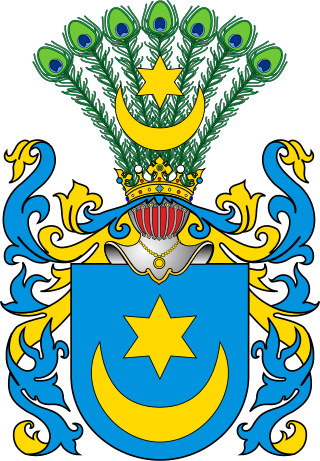
Leliwa is a Polish coat of arms. It was used by several hundred szlachta families during the existence of the Kingdom of Poland and the Polish–Lithuanian Commonwealth, and remains in use today by many of the descendants of these families. There are several forms of the arms, all of which bear the name, Leliwa, but which may be distinguished as variations of the same arms by the addition of a Roman numeral. In 19th century during a pan South-Slavic Illyrian movement heraldic term Leliwa also entered Croatian heraldry as a name for the coat of arms considered to be the oldest known symbol; Bleu celeste, a mullet of six points Or surmounted above a crescent Argent – A golden six-pointed star over a silver crescent moon on a blue shield, but also as a name for all other coats of arms that have a crescent and a mullet.

Ciołek is a Polish coat of arms, one of the oldest in medieval Poland. It was used by many szlachta (noble) families under the late Piast dynasty, under the Polish–Lithuanian Commonwealth, during the Partitions of Poland, and in the 20th century. The variant names "Siolek" and "Cialek" arose from miscommunication among early-20th-century Polish immigrants to the United States.
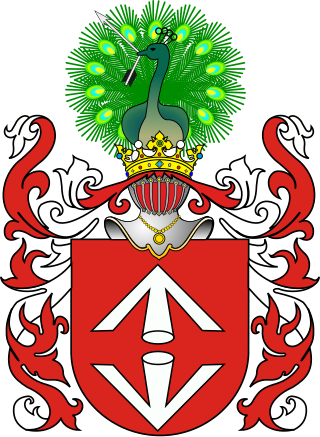
Bogoria is a Polish coat of arms. It was used by several szlachta families in medieval Poland and later under the Polish–Lithuanian Commonwealth, branches of the original medieval Bogoriowie family as well as families connected with the Clan by adoption.

Pierzchała (Roch) is a Polish coat of arms. It was used by several szlachta families in the times of the Kingdom of Poland and the Polish–Lithuanian Commonwealth.

Poraj is a Polish Coat of Arms. Used by several knighthood families of medieval Poland and noble families of the Polish–Lithuanian Commonwealth - those descended in the male-line from the Poraj family and those allowed into the heraldic clan by adoption.

Topór is a Polish coat of arms. It was used by several szlachta (noble) families in medieval Poland and under the Polish–Lithuanian Commonwealth.

Świńka is a Polish coat of arms. It was used by several szlachta (noble) families.

Łodzia is a Polish coat of arms. It was used by many noble families of the Kingdom of Poland and the Polish–Lithuanian Commonwealth. A variant serves as the coat of arms of the city of Łódź. It's a classic example of the so-called canting arms well known in European heraldry as it was borne by the medieval lords de Łodzia and their clan. Hence the boat in the shield, clearly alluding to the estate's name literally meaning Boat. Coats of Arms in the Polish Lithuanian Commonwealth were a symbol of a heraldic clan.

Kościesza - is a Polish coat of arms used by szlachta families in the times of Kingdom of Poland and the Polish–Lithuanian Commonwealth.
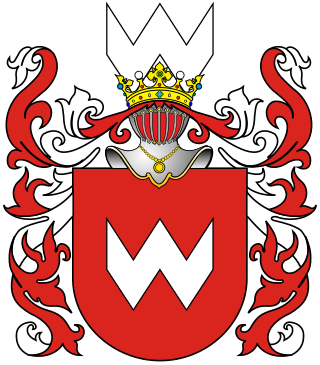
Abdank is a Polish coat of arms. It was used by several szlachta families in the times of the Kingdom of Poland and the Polish–Lithuanian Commonwealth.
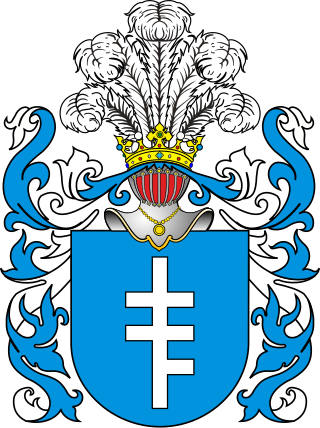
Pilawa is a Polish coat of arms. It was used by many noble families known as szlachta in Polish in medieval Poland and later under the Polish–Lithuanian Commonwealth, branches of the original medieval Piława Clan (Pilawici) family as well as families connected with the Clan by adoption.
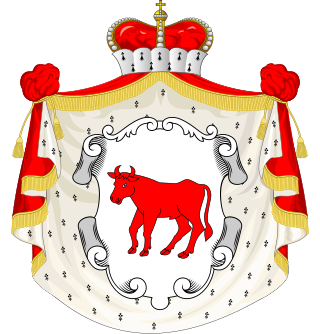
The House of Poniatowski is a prominent Polish family that was part of the nobility of Poland. A member of this family, Stanisław Poniatowski, was elected as King of Poland and reigned from 1764 until his abdication in 1795. Since Polish adjectives have different forms for the genders, Poniatowska is the equivalent name for a female member of this family.
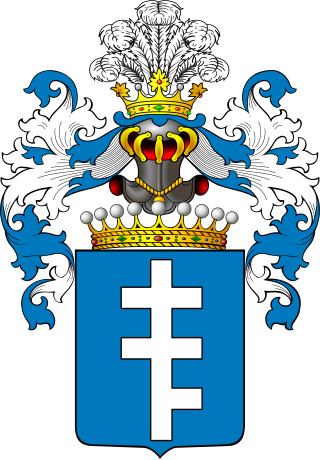
The House of Potocki was a prominent Polish noble family in the Kingdom of Poland and magnates of the Polish–Lithuanian Commonwealth. The Potocki family is one of the wealthiest and most powerful aristocratic families in Poland.

Prus II Wilczekosy is a Polish coat of arms. It was used by several szlachta families in the times of the Polish–Lithuanian Commonwealth.
Polish heraldry is typical to the Polish nobility/szlachta, which has its origins in Middle Ages knights/warriors clans that provided military support to the King, Dukes or overlords.

Michał Jan Borch was a Polish-Livonian naturalist and writer. It is interesting to mention the impact of Polish Count Michał Jan Borch in understanding the nature of truffles. The whitish truffle is named after him.